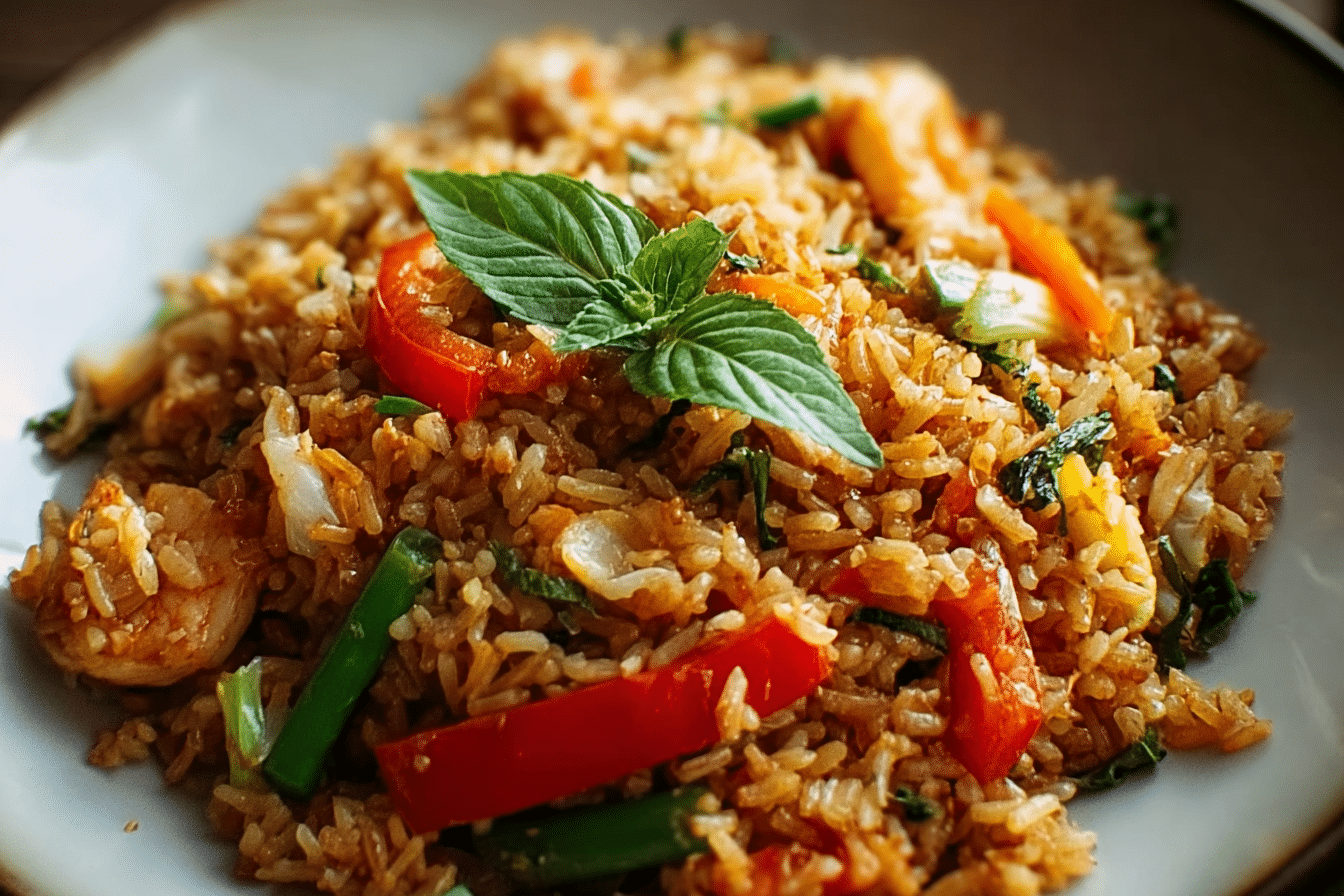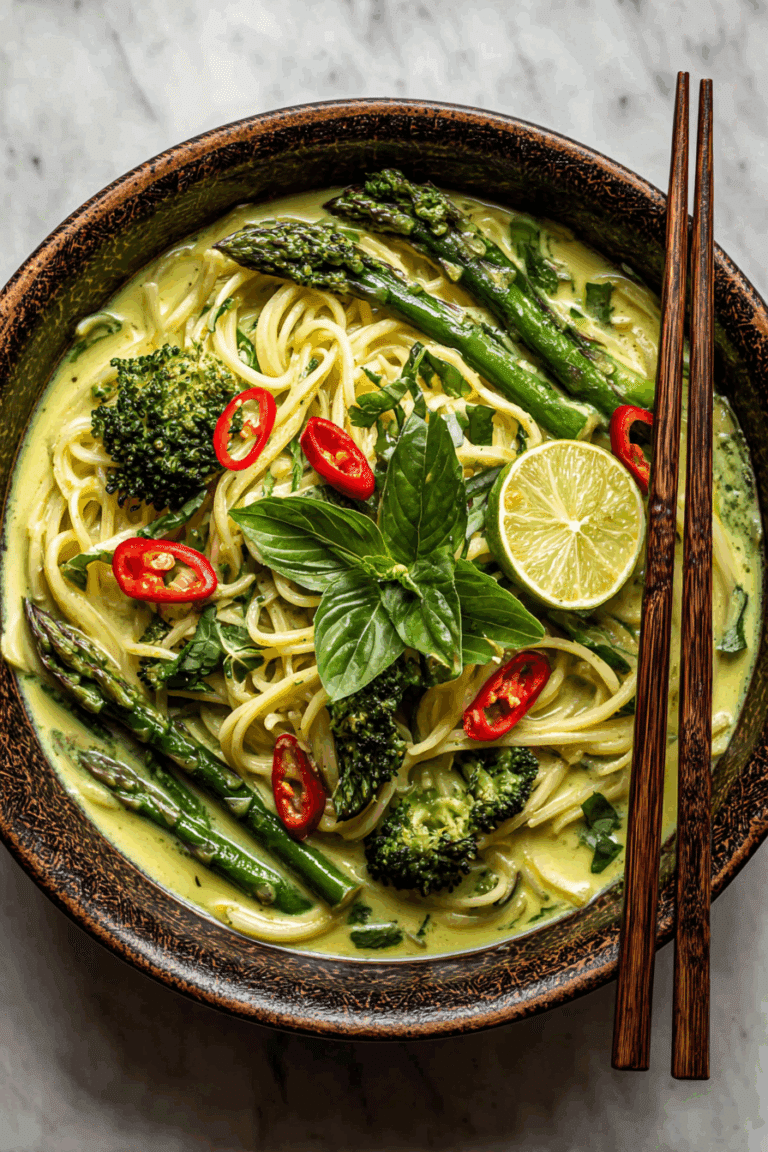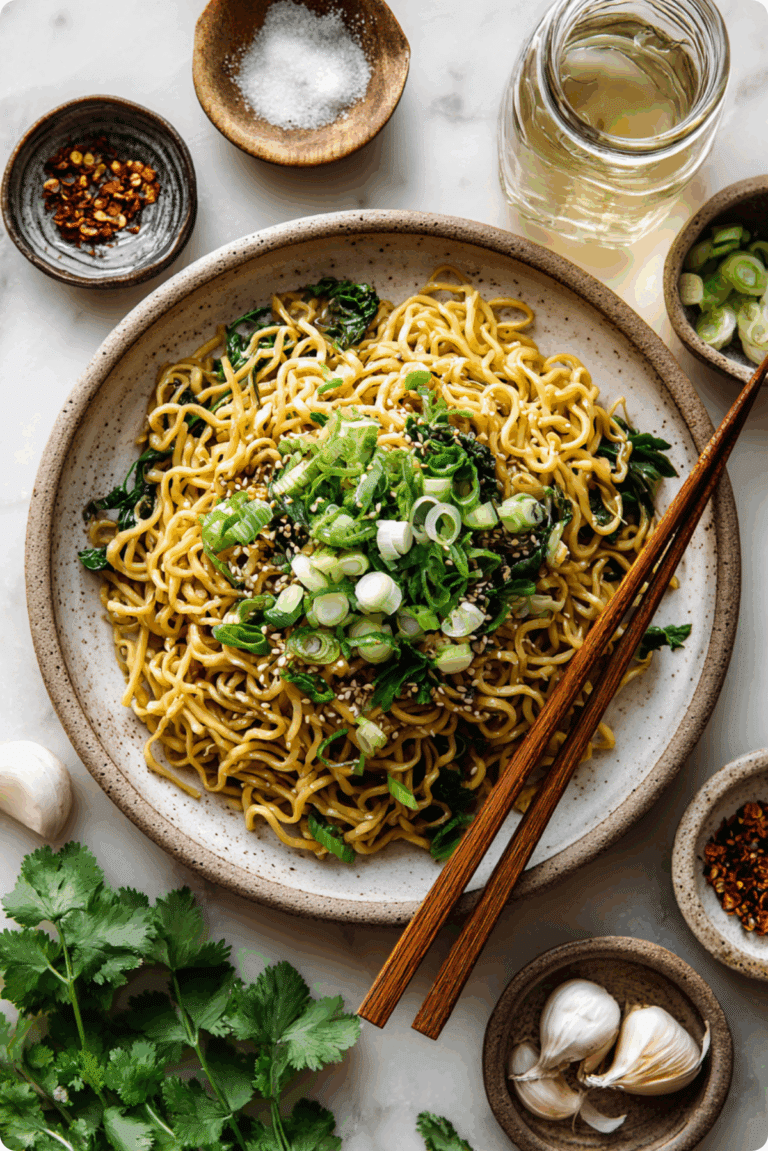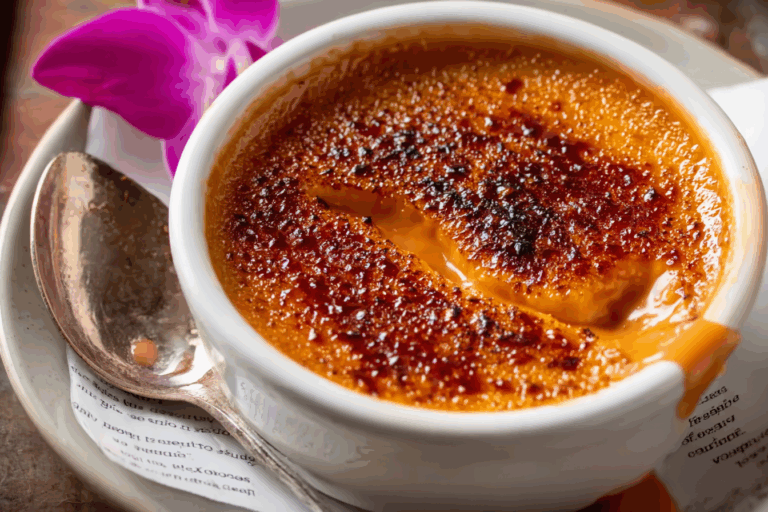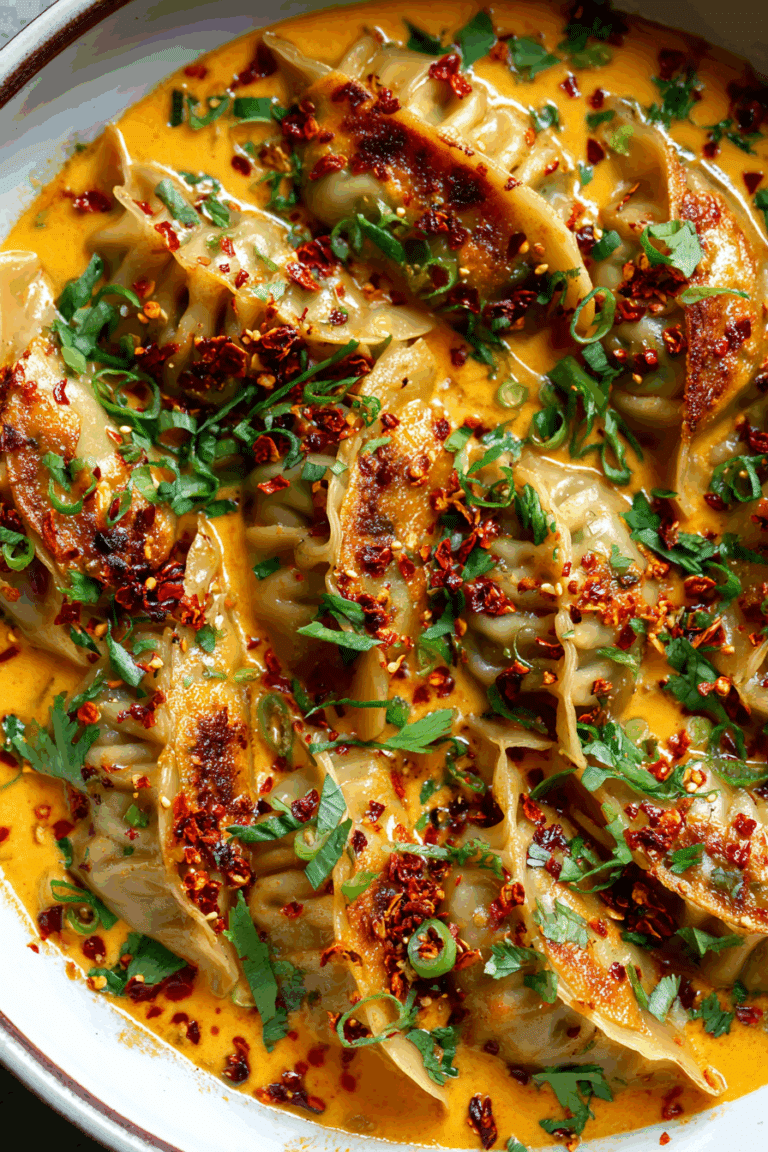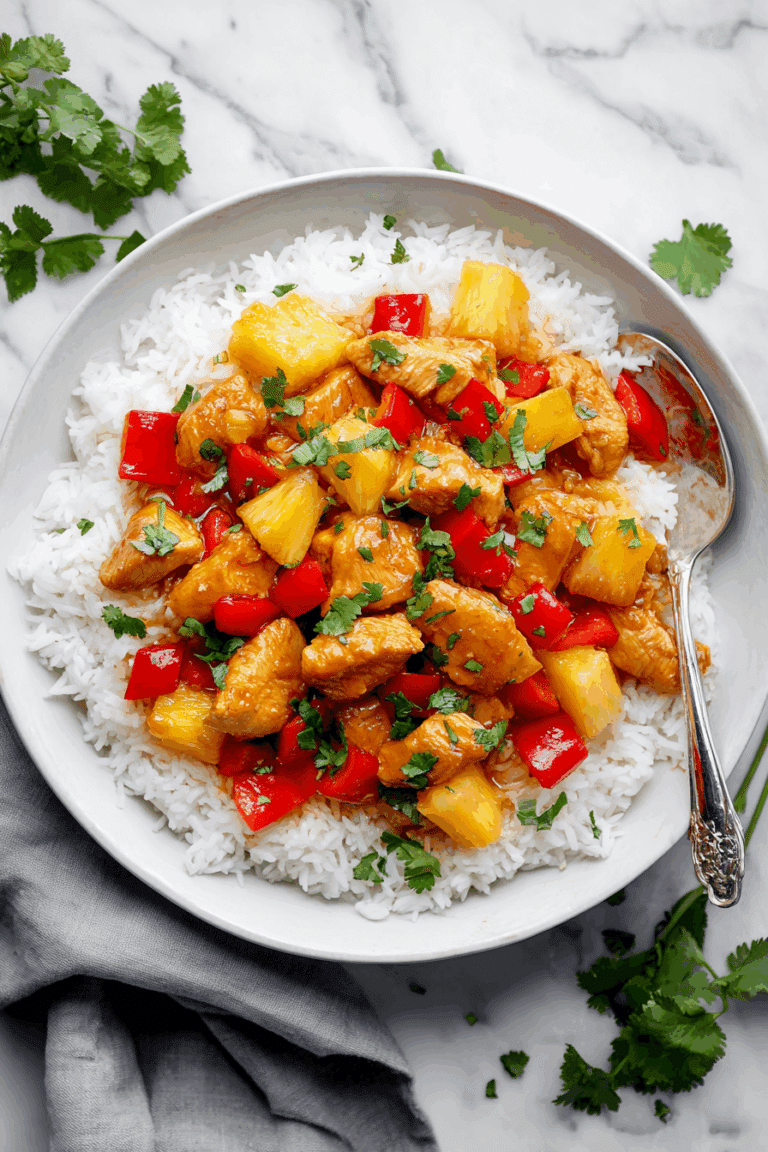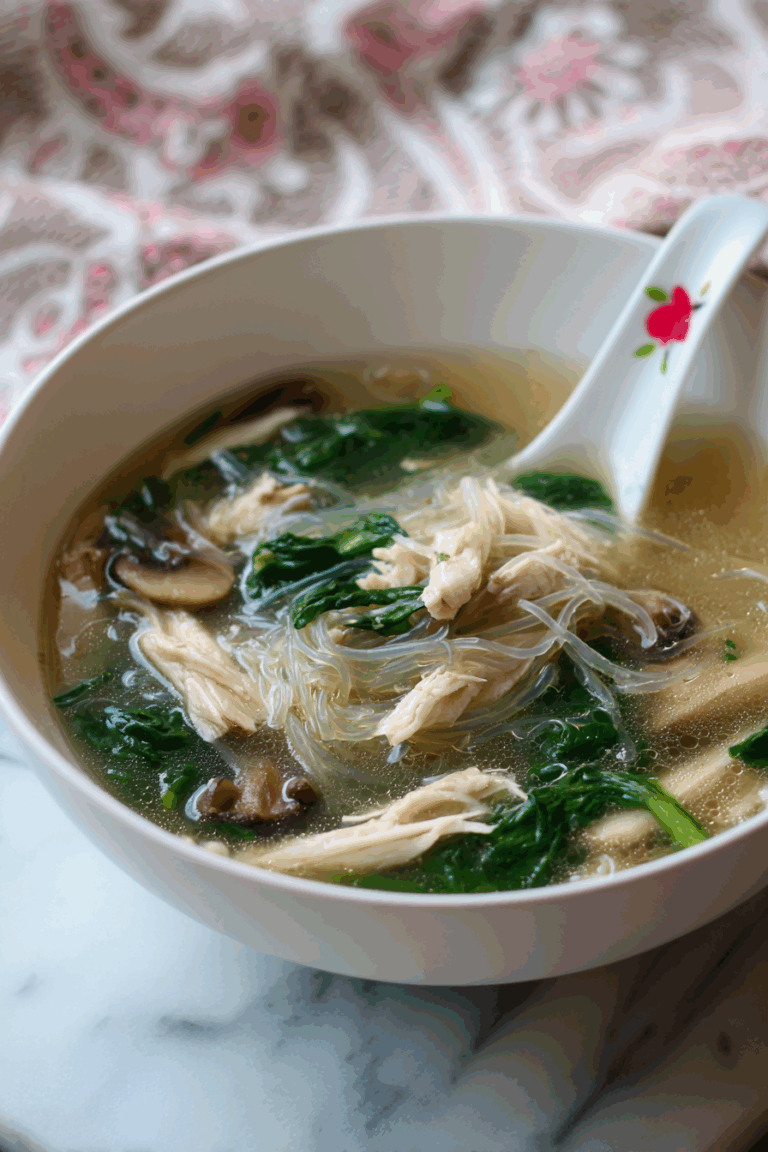How To Make Thai Curry Fried Rice
Thai Curry Fried Rice is one of those dishes that makes your whole kitchen smell like a street food stall in Bangkok. The aroma of curry paste sizzling in a hot wok, the sound of day-old rice being tossed with coconut milk and fresh vegetables, and the sight of colorful herbs dancing in the steam, all come together to create something so comforting yet exciting.
Hi there, and welcome to Just Thai Recipes, where every recipe is born from a genuine love of Thai flavors and a deep respect for tradition. On our About page, I share how my journey began in a tiny Thai kitchen, surrounded by the sound of sizzling woks and laughter. My grandmother taught me how to balance spicy, sweet, salty, and sour in every dish, and that passion has stayed with me ever since. Cooking Thai Curry Fried Rice always brings me back to those early days, where food was more than a meal, it was a story shared with family and friends.
In this post, you’ll learn exactly how to make authentic Thai Curry Fried Rice using simple ingredients and step-by-step instructions. We’ll talk about substitutions, tips for perfect texture, and how to adjust the spice level so everyone at your table falls in love with it. Whether you prefer chicken, tofu, or shrimp, this recipe will become your new favorite weeknight dinner.
Table of Contents
Table of Contents
Ingredients
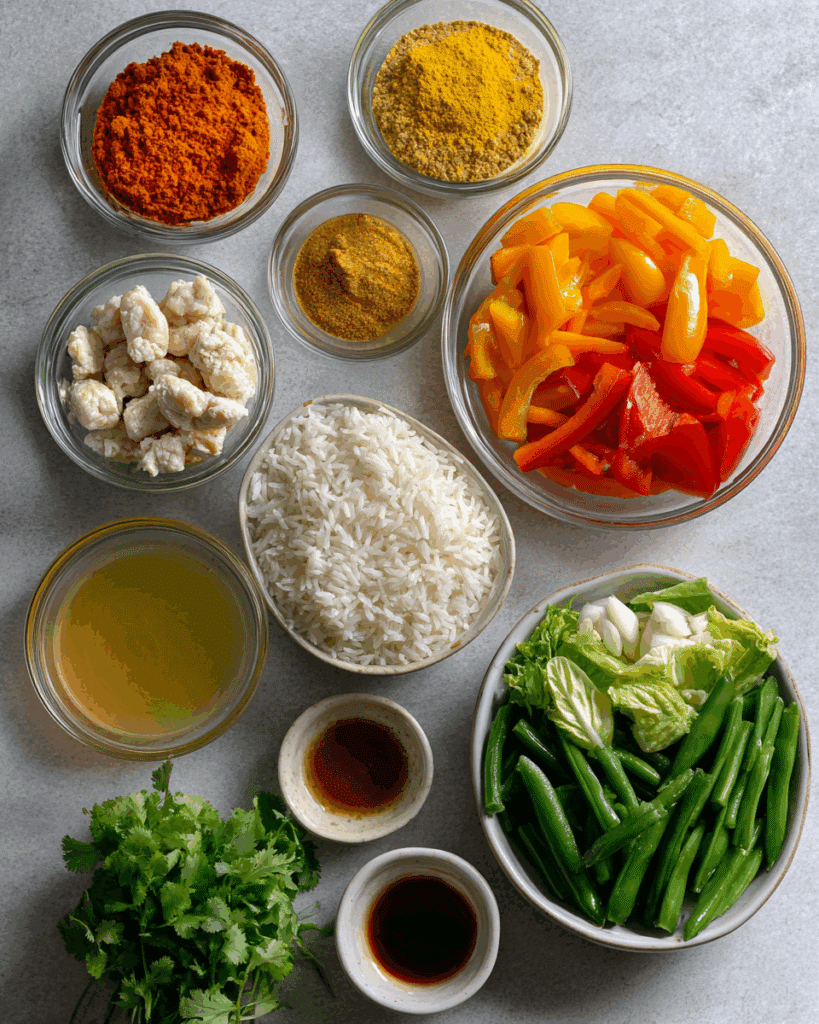
To make the best Thai Curry Fried Rice, you don’t need complicated ingredients, just good-quality staples and a little love. Here’s what you’ll need:
- 4 cups day-old cooked jasmine rice: Using day-old rice is key because it’s drier and fries better without becoming mushy.
- 3 tablespoons Thai curry paste: Any type works beautifully, whether it’s Massaman, Panang, Yellow, Green, or Red. Adjust according to your spice tolerance.
- 1.5 cups mixed vegetables: Bell peppers, carrots, green beans, cabbage, or eggplant, whatever you have in your fridge.
- 1.5 cups protein of your choice: Cooked chicken, shrimp, tofu, pork, or tempeh all soak up the curry flavor.
- ½ cup coconut milk, divided: This gives the rice that creamy richness Thai food is famous for.
- 1–2 tablespoons fish sauce, to taste.
- 1–2 tablespoons oyster sauce, for depth and umami.
- 1–3 teaspoons brown sugar, to balance the heat and saltiness.
- A handful of Thai basil and cilantro leaves, optional but highly recommended.
- 2 kaffir lime leaves, slivered thin, for aroma.
If you love exploring variations like Indian fried rice with curry sauce or Chinese fried rice with curry sauce, you’ll notice how Thai Curry Fried Rice stands out for its use of coconut milk and aromatic herbs. That unique flavor combination gives it a creamy, slightly sweet, and deeply savory character.
Step-by-Step Instructions
1. Stir-Fry the Curry Base
Heat a few tablespoons of oil in a large wok over medium-high heat. Once hot, add one tablespoon of Thai curry paste and stir-fry until fragrant. The aroma should fill the kitchen. Add about three tablespoons of coconut milk and stir until it bubbles gently. This is the flavor base for your Thai Curry Fried Rice, so let it develop for a minute or two.
2. Add the Protein and Veggies
Add your chosen protein, like shrimp or chicken, and cook until nearly done. Next, toss in your vegetables and stir-fry until just softened. Remove everything from the pan and set aside.
3. Stir-Fry the Rice
Add a little more oil to the wok, then stir in the remaining curry paste and coconut milk. When it starts to bubble again, add your four cups of day-old jasmine rice. Break up the clumps with your spatula and toss until every grain is coated in golden curry goodness.
4. Bring It All Together
Return the cooked protein and veggies to the wok. Add the fish sauce, oyster sauce, and brown sugar. Stir until everything is evenly combined, and the sauce clings to the rice. Taste and adjust seasoning if needed.
5. Finish with Herbs
Turn off the heat and fold in Thai basil, cilantro, and kaffir lime leaves. These herbs brighten up the dish and make your Thai Curry Fried Rice feel fresh and authentic.
For reference and variation ideas, you can also visit RecipeTin Eats Thai Chicken Fried Rice and Thai Foodie’s Thai Curry Fried Rice Guide, two excellent resources for understanding different takes on this flavorful meal.
Tips & Tricks
Making Thai Curry Fried Rice isn’t complicated, but a few small tweaks make all the difference.
- Use cold, day-old rice. Freshly cooked rice will clump and turn mushy.
- Control the heat. If you’re sensitive to spice, start with one tablespoon of curry paste. You can always add more later.
- Balance flavors. Thai cuisine is all about balance. If your dish tastes too salty, add a touch of sugar or coconut milk. Too spicy? A squeeze of lime helps tone it down.
- Add crunch. Toss in some roasted cashews or sliced green onions for texture.
- Fry in batches if needed. Overcrowding the wok can steam the rice instead of frying it.
These tips apply whether you’re making fried rice with curry sauce and coconut milk or Indian curry fried rice. Once you get the balance right, it becomes second nature to adjust seasoning to your liking.
Variations
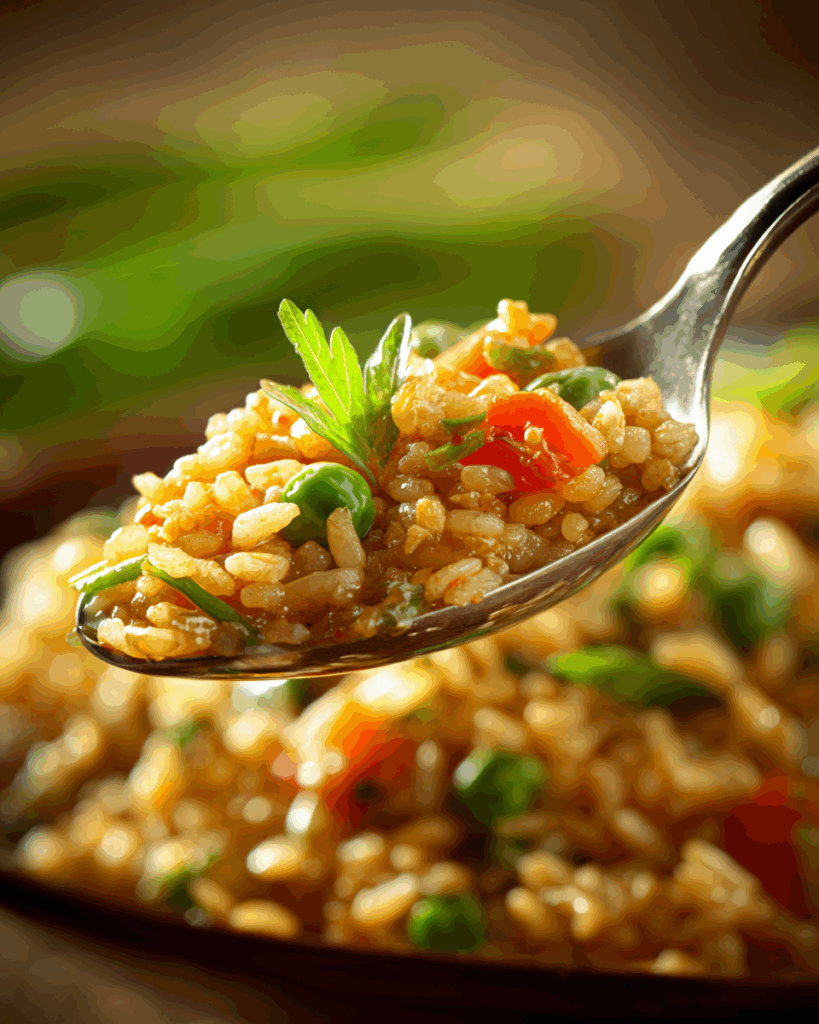
One of the best things about Thai Curry Fried Rice is how customizable it is.
- Thai Curry Fried Rice with Chicken
A crowd favorite, this version uses tender chicken pieces marinated lightly with soy sauce before frying. It’s perfect for quick dinners and pairs beautifully with Thai iced tea. - Vegetarian Thai Curry Fried Rice
Swap the fish sauce for soy sauce and use tofu or tempeh. The curry paste and coconut milk provide enough richness that you won’t miss the meat. - Seafood Thai Curry Fried Rice
Combine shrimp, squid, and mussels for a vibrant seafood version that feels like a celebration. - Thai Egg Fried Rice with Curry Paste
Crack two eggs into the wok before adding the rice. Scramble them lightly and mix everything together for extra texture and protein. - Spicy Panang Curry Fried Rice
For those who love heat, use Panang curry paste and add chopped Thai chilis. Serve it with a wedge of lime for that signature zing.
Each variation keeps the essence of Thai Curry Fried Rice but adds its own personality.
Nutrition & Health Benefits
When you think of Thai Curry Fried Rice, the first thing that comes to mind might be comfort and flavor, but this dish actually carries quite a few surprising health benefits. What makes Thai food so special is the balance between indulgence and nourishment. Every bite offers something your body can use, from energy to vitamins to healthy fats.
Let’s start with the rice. Jasmine rice is the foundation of Thai Curry Fried Rice, and while it’s known for its fragrant aroma and fluffy texture, it’s also a great source of carbohydrates, which are your body’s main source of fuel. Many people think carbs are bad, but the truth is, they’re essential for energy, especially when paired with lean protein and fiber-rich vegetables.
Then there’s the protein. Whether you choose chicken, shrimp, tofu, or tempeh, you’re adding a layer of nutrition that helps repair muscles and keep you full for hours. Chicken gives you lean protein with minimal fat, shrimp adds iodine and omega-3s, and tofu brings plant-based protein and calcium. If you’re vegetarian or vegan, tofu or tempeh with soy sauce instead of fish sauce makes Thai Curry Fried Rice a complete, wholesome meal.
Coconut milk is the ingredient that ties everything together. While it’s richer than other liquids, it also provides healthy fats, specifically medium-chain triglycerides (MCTs), which are known to boost metabolism and support brain health. The natural creaminess of coconut milk also means you can use less oil during cooking.
Vegetables are another major contributor. Bell peppers add vitamin C and antioxidants, carrots bring beta-carotene for healthy skin, and green beans and cabbage add fiber for digestion. If you use eggplant or broccoli, you’ll add even more nutrients while keeping things colorful and fresh.
Finally, don’t underestimate the power of Thai herbs. Thai basil, cilantro, and kaffir lime leaves do more than make your kitchen smell like a Thai restaurant. They’re packed with essential oils and antioxidants that aid digestion, support immunity, and reduce inflammation.
Altogether, Thai Curry Fried Rice isn’t just comfort food. It’s a balanced meal that gives you energy, supports your metabolism, and brings in a whole rainbow of nutrients. And when you cook it at home, you can easily control the sodium and oil levels, making it even healthier.
Make-Ahead, Storage & Freezing
One of the reasons I love Thai Curry Fried Rice is that it’s incredibly practical. You can cook a big batch on a Sunday and enjoy it for lunch or dinner throughout the week. The flavors even get stronger the next day, which makes it a perfect meal prep option.
If you want to make it ahead, start by cooking your jasmine rice the night before. Spread it on a baking sheet to cool completely, then refrigerate it. This drying step helps the grains firm up, giving you that signature fried rice texture later. You can also chop all your vegetables and protein in advance and store them separately in airtight containers.
When it’s time to cook, just heat your wok, add oil and curry paste, and you’re halfway done. Having everything prepped ahead of time makes the cooking process take no more than 10 minutes.
For storing leftovers, always let your Thai Curry Fried Rice cool to room temperature first. Then place it in an airtight glass container. It keeps well for up to three days in the refrigerator without losing flavor.
If you want to freeze it, portion it into single servings and store in freezer-safe containers or resealable bags. Squeeze out as much air as possible to avoid freezer burn. It will last up to two months in the freezer. When reheating, don’t use the microwave right away. Instead, let it thaw in the fridge overnight and reheat it in a pan with a drizzle of oil or a splash of coconut milk to bring back that silky texture.
Another tip is to add a little fresh Thai basil or a squeeze of lime right before serving your reheated Thai Curry Fried Rice. It revives the aroma and gives the dish that fresh-out-of-the-wok feeling again.
Common Mistakes to Avoid
Even though Thai Curry Fried Rice is simple to make, there are a few common mistakes that can change its texture or taste. The good news is, once you know them, you’ll never go wrong again.
1. Using freshly cooked rice.
This is the biggest mistake most people make. Freshly cooked rice still has steam and moisture trapped inside, which turns your fried rice soggy. Always use rice that’s been chilled for at least a few hours. The grains should be slightly dry so they fry instead of steaming.
2. Not frying the curry paste properly.
Curry paste needs to bloom in hot oil to release its full flavor. If you add other ingredients too soon, you’ll miss out on that deep, aromatic base that makes Thai Curry Fried Rice so irresistible. Give it at least 30 seconds to sizzle before adding coconut milk or vegetables.
3. Overcrowding the wok.
If your pan is too full, the ingredients will steam instead of fry. It’s better to cook in two smaller batches so everything gets that lovely charred edge.
4. Adding too much sauce.
Fish sauce and oyster sauce are powerful. Adding too much can make the dish overly salty or heavy. Start with small amounts, taste, and adjust gradually.
5. Forgetting the herbs at the end.
Fresh herbs like Thai basil and cilantro should go in after you turn off the heat. If you add them too early, they wilt and lose their fragrance.
Each of these small details might seem simple, but they make the difference between a decent dish and restaurant-quality Thai Curry Fried Rice. Once you get it right, it becomes a recipe you’ll cook again and again.
Cultural and Historical Background
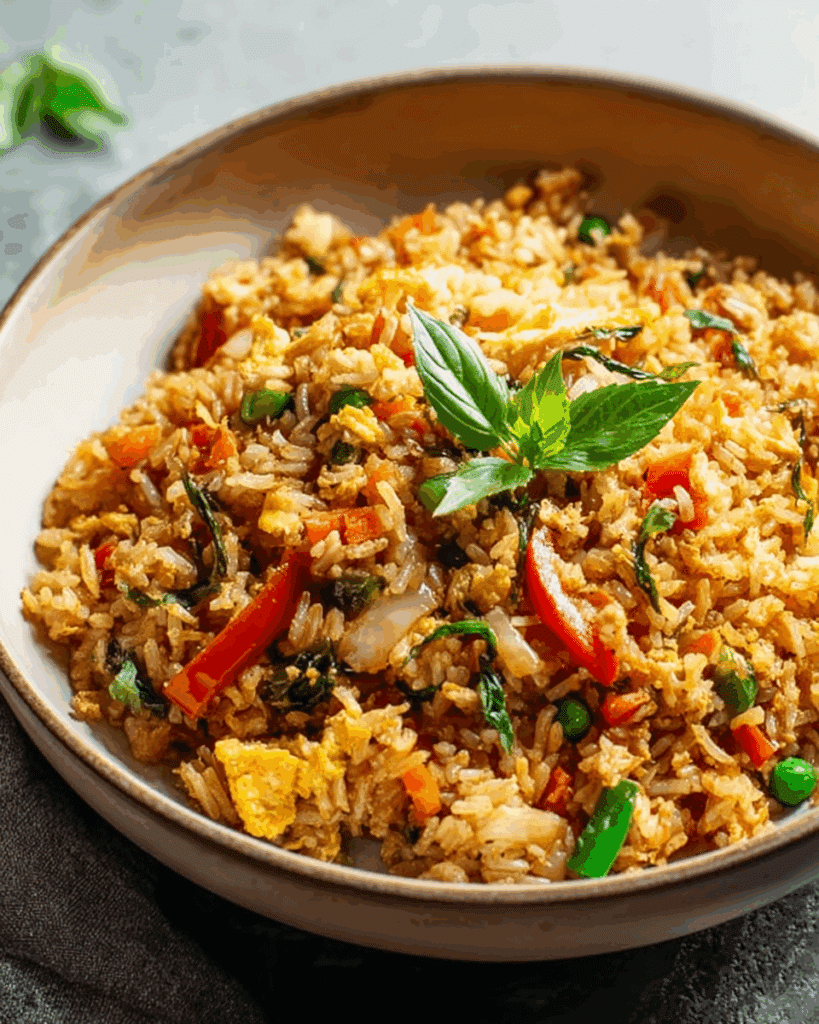
To understand why Thai Curry Fried Rice is so beloved, you need to know a bit about how it came to be. Like many Thai dishes, it’s a beautiful fusion of influences. The technique of stir-frying rice originally came from Chinese immigrants who brought their cooking methods to Thailand generations ago. The Thai people adopted this idea and made it their own by adding curry paste and coconut milk, two ingredients central to Thai cuisine.
Over time, Thai Curry Fried Rice became a household dish, found in everything from street food markets to family dinners. It reflects Thailand’s culinary philosophy of balance spicy, salty, sweet, and sour all living in harmony.
In Thailand, you might find different versions depending on the region. In the south, the curry paste tends to be spicier, often with red curry or Massaman flavors. In the north, it might be milder and more aromatic, using yellow curry or extra coconut milk. Each variation carries the signature of the region’s local ingredients and tastes.
Another cultural detail that makes Thai Curry Fried Rice special is how it’s served. It’s usually paired with simple sides like a fried egg, cucumber slices, or lime wedges. Sometimes you’ll get a small bowl of Nam Pla Prik, a dipping sauce made of fish sauce, chopped chili, and lime juice. This sauce adds a sharp brightness that cuts through the richness of the rice.
Eating Thai Curry Fried Rice isn’t just about satisfying hunger. It’s about connection. Families often cook it together, chatting as they stir-fry and sharing stories at the table. For many Thai people, it’s a reminder of home, and for travelers, it’s often their first taste of real Thai comfort food.
Serving Suggestions
The beauty of Thai Curry Fried Rice lies in how versatile it is. You can serve it as a main dish, as a side, or even as part of a larger Thai-inspired meal. Here are a few ideas that work wonderfully.
With a Fried Egg:
A sunny-side-up egg with crispy edges and a soft yolk is one of the best toppings you can add. When the yolk breaks and mixes into the rice, it creates a creamy texture that complements the curry flavor beautifully.
With Fresh Sides:
Thai food is all about contrast, so pairing your rice with something cool and crunchy balances the heat. Sliced cucumbers, fresh lettuce, or a simple green papaya salad (som tam) are great choices.
As a Complete Meal:
If you add protein like chicken or shrimp and a variety of vegetables, Thai Curry Fried Rice stands perfectly on its own. A squeeze of lime and a sprinkle of chopped cilantro make it fresh and bright.
With Drinks:
Serve it with Thai iced tea, coconut water, or even a cold beer if you want something refreshing. The mild sweetness of Thai iced tea pairs surprisingly well with the gentle spice of curry fried rice.
For Parties:
You can double the recipe and serve it buffet-style. It stays warm easily and guests love the colorful look of the rice studded with vegetables and herbs.
Whether you’re serving it for dinner with family or as a dish to impress your friends, Thai Curry Fried Rice always delivers that comforting, homey vibe that people love.
Conclusion
Thai Curry Fried Rice is more than just a way to use leftover rice. It’s a dish that captures the heart of Thai cooking vibrant, balanced, and comforting. Each ingredient has its purpose, from the rich coconut milk that adds creaminess, to the fragrant herbs that make your kitchen smell incredible.
What I love most about making this dish is how adaptable it is. You can use whatever curry paste or vegetables you have on hand and it still turns out delicious. The process itself feels meditative, from sizzling the curry paste to tossing the rice until every grain shines with flavor.
If you’ve never tried making Thai Curry Fried Rice at home, this is your sign to do it. Once you master it, you’ll never look at leftover rice the same way again. It’s the kind of meal that brings warmth to the table and smiles to everyone who tastes it.
So next time you have some extra rice in the fridge, skip the takeout and whip up your own Thai Curry Fried Rice. You’ll not only impress yourself but also anyone lucky enough to join you for dinner.
FAQ
Why does my Thai Curry Fried Rice taste bland?
You might not be using enough curry paste, or your wok wasn’t hot enough to fry the paste properly. Make sure to fry the curry paste in oil before adding anything else, and taste as you go. If needed, add a splash of fish sauce, lime juice, or sugar to balance it out.
Can I make Thai Curry Fried Rice gluten-free?
Absolutely. Simply use gluten-free soy sauce instead of oyster sauce and make sure your curry paste is gluten-free. Most traditional Thai curry pastes already are, but it’s always worth checking the label.
What’s the best curry paste to use for Thai Curry Fried Rice?
It depends on your spice preference. Red curry paste gives a balanced flavor, green curry paste is spicier and fresher, while yellow curry paste is mild and slightly sweet. Panang and Massaman curry pastes add deeper, nutty flavors.
Can I make Thai Curry Fried Rice without coconut milk?
Yes, you can. While coconut milk gives the dish its signature creaminess, you can replace it with a little water or vegetable broth if you prefer a lighter version. The taste will be different, but still flavorful if you balance the curry paste and seasonings.
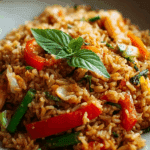
Thai Curry Fried Rice
- Prep Time: 15 minutes
- Cook Time: 15 minutes
- Total Time: 30 minutes
- Yield: 4 servings 1x
- Category: Main Course
- Method: Stir-Fry
- Cuisine: Thai
- Diet: Halal
Description
A flavorful and aromatic Thai Curry Fried Rice made with day-old jasmine rice, curry paste, coconut milk, mixed vegetables, and your choice of protein. This easy Thai-inspired dish combines the comfort of fried rice with the bold flavors of Thai curry for a quick and satisfying meal.
Ingredients
- 4 cups day-old cooked jasmine rice
- 3 tbsp Thai curry paste (Massaman, Panang, Yellow, Green, or Red), divided, adjust to taste
- 1.5 cups mixed vegetables (bell peppers, carrots, green beans, cabbage, eggplant, or any of choice)
- 1.5 cups protein of choice (cooked chicken, shrimp, Thai fried tofu, pork, or tempeh)
- 1/2 cup coconut milk, divided
- 1–2 tbsp fish sauce, to taste
- 1–2 tbsp oyster sauce, to taste
- 1–3 tsp brown sugar, to taste
- Handful of Thai basil and cilantro leaves (optional)
- 2 kaffir lime leaves, slivered (optional)
- 2–3 tbsp vegetable oil, for frying
Instructions
- Heat 2 tablespoons of oil in a large wok or skillet over medium-high heat. Add 1 tablespoon of Thai curry paste and stir-fry until fragrant, about 30 seconds.
- Pour in 3 tablespoons of coconut milk and stir until the mixture bubbles and the oil begins to separate slightly from the paste.
- Add your chosen protein and stir-fry until mostly cooked through. Then add your vegetables and cook until just softened. Remove everything from the wok and set aside.
- Add a bit more oil to the wok, then stir in the remaining curry paste and the rest of the coconut milk. Stir-fry until bubbling and aromatic.
- Add the day-old jasmine rice, breaking up any clumps with your spatula. Toss until all the grains are evenly coated in the curry sauce.
- Return the cooked protein and vegetables to the wok. Add fish sauce, oyster sauce, and brown sugar to taste. Stir until everything is evenly mixed and heated through.
- Turn off the heat and mix in Thai basil, cilantro, and kaffir lime leaves if using. Taste and adjust seasoning if needed.
- Serve hot with lime wedges or Nam Pla Prik on the side for extra spice.
Notes
- Use day-old rice for the best texture, as fresh rice tends to be too moist and can become mushy.
- If you prefer less spice, start with 1 tablespoon of curry paste and adjust gradually.
- For a vegetarian or vegan version, substitute fish sauce with soy sauce or tamari and skip the oyster sauce.
- Thai basil adds authentic flavor but can be replaced with sweet basil if unavailable.
- Garnish with lime wedges or extra herbs for freshness just before serving.
Nutrition
- Serving Size: 1 bowl (about 1.5 cups)
- Calories: 480
- Sugar: 6g
- Sodium: 820mg
- Fat: 18g
- Saturated Fat: 9g
- Unsaturated Fat: 8g
- Trans Fat: 0g
- Carbohydrates: 58g
- Fiber: 3g
- Protein: 20g
- Cholesterol: 55mg
Keywords: Thai Curry Fried Rice, curry fried rice, Thai fried rice recipe, fried rice with coconut milk, easy Thai curry rice, Thai chicken curry fried rice

